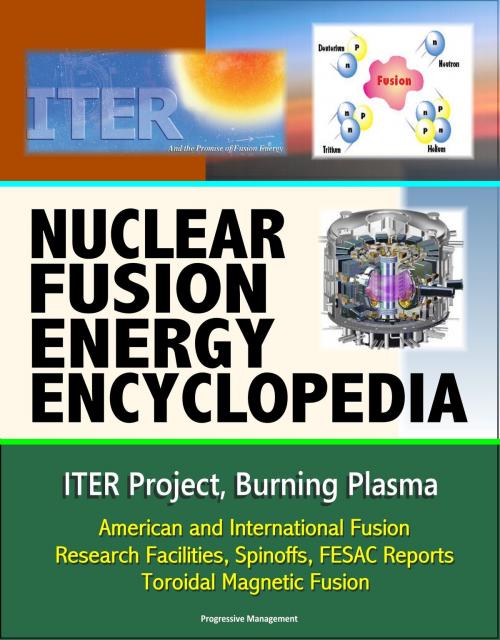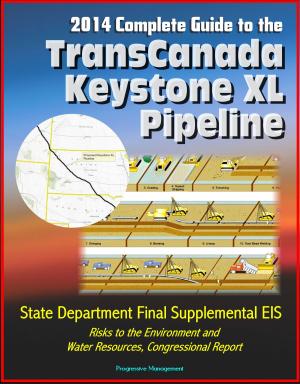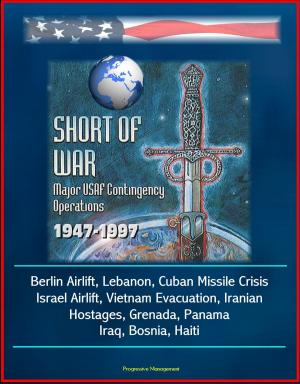Nuclear Fusion Energy Encyclopedia: ITER Project, Burning Plasma, American and International Fusion Research Facilities, Spinoffs, FESAC Reports, Toroidal Magnetic Fusion
Nonfiction, Science & Nature, Technology, Nuclear Energy, Science, Physics, Nuclear Physics| Author: | Progressive Management | ISBN: | 9781311683373 |
| Publisher: | Progressive Management | Publication: | February 10, 2014 |
| Imprint: | Smashwords Edition | Language: | English |
| Author: | Progressive Management |
| ISBN: | 9781311683373 |
| Publisher: | Progressive Management |
| Publication: | February 10, 2014 |
| Imprint: | Smashwords Edition |
| Language: | English |
With twenty-six chapters and thousands of pages of text, this unique compilation of official information provides an incredibly comprehensive overview of all aspects of the worlds' quest for nuclear fusion energy, including the ambitious ITER experimental burning plasma project, U.S. fusion research and facilities, international efforts in China, Russia, South Korea, and other countries, and plans for the DEMO reactor and full-scale electrical generation plants.
Contents: DOE Fusion Energy Sciences * ITER Project Overview and U.S. Contribution * Next Generation of Fusion Energy Research (Hearing) * Fusion Energy (GAO) * Fusion Spinoffs: Making A Difference Today * Report of the FESAC Subcommittee on the Priorities of the Magnetic Fusion Energy Science Program 2013 * Report of the FESAC Subcommittee on the Prioritization of Proposed Scientific User Facilities for the Office of Science 2013 * Fusion Energy Sciences Advisory Committee Report on Opportunities for and Modes of International Collaboration in Fusion Energy Sciences Research during the ITER Era - February 2012 * Fusion Energy Sciences Advisory Committee Report on Opportunities for Fusion Materials Science and Technology Research Now and During the ITER Era February 2012 * Report of the Burning Plasma Organization Panel on Planning for US Participation in ITER - September 3, 2009 * Priorities, Gaps and Opportunities: Towards A Long-Range Strategic Plan For Magnetic Fusion Energy - A Report to the Fusion Energy Sciences Advisory Committee - October 2007 * Report of the 2005 FESAC Facilities Panel - Characteristics and Contributions of the Three Major United States Toroidal Magnetic Fusion Facilities * FESAC A Plan for the Development of Fusion Energy * Report of the Fusion Energy Sciences Advisory Committee Burning Plasma Strategy Panel - A Burning Plasma Program Strategy To Advance Fusion Energy * NSTX-U FY2013 Year End Report * Fusion Energy Sciences Advisory Committee (FESAC) Meeting Minutes * 2000 through 2014 Fusion Energy Sciences Congressional Budget Request (various) * ITER Presentations
Fusion is a key element in long-term US energy plans. ITER will allow scientists to explore the physics of a burning plasma at energy densities close to that of a commercial power plant. This is a critical step towards producing and delivering electricity from fusion to the grid. Nuclear fusion occurs naturally in stars, like our sun. When hydrogen gets hot enough, the process of fusion occurs, releasing energy. On earth, producing fusion reactions by heating, compressing and confining hydrogen plasmas at 100 million degrees is a significant challenge. After years of research, scientists have learned that it is possible to create a self-heated fusion plasma and truly "bring a star to earth." Fusion has the potential to bring clean, abundant, safe energy to most of the world’s populations. The fusion process produces no greenhouse gas emissions and generates no high-level radioactive waste. It is fueled by readily available resources: Deuterium (heavy hydrogen) is plentiful in water and tritium can be produced during the fusion process. Fusion could become a major contributor to the power grid for centuries to come.
ITER (Latin for "the way") is a critical step between today’s studies of plasma physics and tomorrow’s fusion power plants producing electricity and hydrogen. An unprecedented international collaboration of scientists and engineers led to the design of this advanced physics experiment. The ITER Members are China, the European Union, India, Japan, Russia, South Korea, and the United States. ITER construction is underway in southeastern France (St. Paul lez Durance), and components fabricated by the Members are being delivered to the construction site. Experimental operations are planned to begin in approximately 10 years and are expected to continue for 20 years, demonstrating production of at least 10 times the power used to heat the fusion fuel.
With twenty-six chapters and thousands of pages of text, this unique compilation of official information provides an incredibly comprehensive overview of all aspects of the worlds' quest for nuclear fusion energy, including the ambitious ITER experimental burning plasma project, U.S. fusion research and facilities, international efforts in China, Russia, South Korea, and other countries, and plans for the DEMO reactor and full-scale electrical generation plants.
Contents: DOE Fusion Energy Sciences * ITER Project Overview and U.S. Contribution * Next Generation of Fusion Energy Research (Hearing) * Fusion Energy (GAO) * Fusion Spinoffs: Making A Difference Today * Report of the FESAC Subcommittee on the Priorities of the Magnetic Fusion Energy Science Program 2013 * Report of the FESAC Subcommittee on the Prioritization of Proposed Scientific User Facilities for the Office of Science 2013 * Fusion Energy Sciences Advisory Committee Report on Opportunities for and Modes of International Collaboration in Fusion Energy Sciences Research during the ITER Era - February 2012 * Fusion Energy Sciences Advisory Committee Report on Opportunities for Fusion Materials Science and Technology Research Now and During the ITER Era February 2012 * Report of the Burning Plasma Organization Panel on Planning for US Participation in ITER - September 3, 2009 * Priorities, Gaps and Opportunities: Towards A Long-Range Strategic Plan For Magnetic Fusion Energy - A Report to the Fusion Energy Sciences Advisory Committee - October 2007 * Report of the 2005 FESAC Facilities Panel - Characteristics and Contributions of the Three Major United States Toroidal Magnetic Fusion Facilities * FESAC A Plan for the Development of Fusion Energy * Report of the Fusion Energy Sciences Advisory Committee Burning Plasma Strategy Panel - A Burning Plasma Program Strategy To Advance Fusion Energy * NSTX-U FY2013 Year End Report * Fusion Energy Sciences Advisory Committee (FESAC) Meeting Minutes * 2000 through 2014 Fusion Energy Sciences Congressional Budget Request (various) * ITER Presentations
Fusion is a key element in long-term US energy plans. ITER will allow scientists to explore the physics of a burning plasma at energy densities close to that of a commercial power plant. This is a critical step towards producing and delivering electricity from fusion to the grid. Nuclear fusion occurs naturally in stars, like our sun. When hydrogen gets hot enough, the process of fusion occurs, releasing energy. On earth, producing fusion reactions by heating, compressing and confining hydrogen plasmas at 100 million degrees is a significant challenge. After years of research, scientists have learned that it is possible to create a self-heated fusion plasma and truly "bring a star to earth." Fusion has the potential to bring clean, abundant, safe energy to most of the world’s populations. The fusion process produces no greenhouse gas emissions and generates no high-level radioactive waste. It is fueled by readily available resources: Deuterium (heavy hydrogen) is plentiful in water and tritium can be produced during the fusion process. Fusion could become a major contributor to the power grid for centuries to come.
ITER (Latin for "the way") is a critical step between today’s studies of plasma physics and tomorrow’s fusion power plants producing electricity and hydrogen. An unprecedented international collaboration of scientists and engineers led to the design of this advanced physics experiment. The ITER Members are China, the European Union, India, Japan, Russia, South Korea, and the United States. ITER construction is underway in southeastern France (St. Paul lez Durance), and components fabricated by the Members are being delivered to the construction site. Experimental operations are planned to begin in approximately 10 years and are expected to continue for 20 years, demonstrating production of at least 10 times the power used to heat the fusion fuel.















